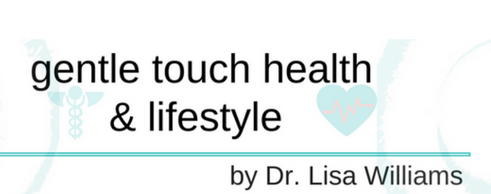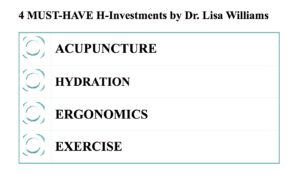
HEALTH PORTFOLIO (H-Portfolio)
H-Asset: Spinal Wealth- Low Back
A healthy spine is the IRA (Individual Retirement Account) of our body. The more you supplement your current “savings”, the greater your health advantage in years to come.
Practice guidelines have been established by the American College of Physicians (2017) for the diagnosis and treatment of low back pain (“nonradicular”) based on clinical findings for improving patient outcomes. Based on the recommendations posed by the College, clinicians and patients should select non-pharmacologic measures to treat low back pain, including acupuncture, exercise, and spinal mobilizations. These specific H-Investments have been part of my gold standard in treating low back pain for many, many years; and now we are reminded once again how we can bridge the gap between health and wealth. Building your H-Portfolio should not be a gamble. Why not take the time to invest wisely before the years slip away from you?
According to the World Health Organization (2013), low back pain lifetime prevalence is estimated at 60 to 70 percent occurrence in industrialized nations. Prevalence increases and peaks between the ages of 35 and 55. Low back pain, is one of the most common alignments afflicting mankind and it is the major cause of disability absence in the workplace. Not only does low back pain affect our work life and therefore our family life, but it leaves us with a tremendous economic burden, with an estimated total cost of 100 to 200 billon dollars a year.
Patients with low back pain want relief, and they think medication has become part of their H-Solution (health-solution). Think again, do not expect “express” care, because the wrong H-Investment could cost you everything you have earned, and it is never too late to invest wisely. Using sound H-Investments can reduce the number of unnecessary doctor visits and/or medication. Patients with low back pain are often prescribed painkillers. These pain medications can lead to other healthcare problems, as well as complicate the course of a patient’s improvement. Side effects from any medications could negatively affect the healing process and effectiveness of treatment. Opioids, for example, have multiple side effects, which include drowsiness and mental slowness, nausea, vomiting, and constipation. More serious side effects include overdose and the possibility of addiction, which is also why opioids are now being considered as the last resort (American College of Physicians, 2017). Medication side effects, changes in dosages, and possible drug interactions could lead to serious health effects, which means your H-Portfolio could take a deep dive.
There are many important MUST-HAVE H-Investments for the low back, and certainly more than my four. However, these four can be used as tools that can prevent and decrease low back pain and improve quality of life, without all the potential side effects of medication. The decision to follow a course of H-Investments must be made as an informed choice, knowing its risks, benefits, and potential alternatives.
Diversify:
Review of the H-Investments
Acupuncture:
My H-Investment: As a licensed acupuncturist, I have recommended acupuncture for low back pain for many years. I have helped many patients successfully overcome pain associated with multiple diagnoses and areas of the body, including herniated discs, scoliosis, spinal stenosis, sciatica, and neuropathy, among others. Acupuncture can also help with relieving some musculoskeletal pain by combining it with Percutaneous Electrical Nerve Stimulation (PENS), which may help reduce the perception of the pain and lessen the time the individual needs medication.
History of this H-Investment: Acupuncture has been practiced for thousands of years and evidence of acupuncture have been found in ancient Chinese ruins, with the discovery of needles and later with the discovery of the earliest book written on Chinese Medicine dated around 305-204 BC. Acupuncture treatment has the advantage of being free of side effects. Patients and healthcare providers have been turning to complementary treatments, like acupuncture, for pain reduction due to its naturally occurring release of painkilling chemicals such as serotonin, endorphins, and acetylcholine. Acupuncture results are cumulative, which means your H-Investment has a low risk and high return, and you can benefit from “compounding.” By reinvesting, you maximize your potential. Present H-Evidence (health-evidence) has found that incorporating acupuncture for patients with chronic low back pain, has shown positive results in decreasing pain level, relapses, and missed work days compared to those who do not receive acupuncture (Bahrami-Taghanaki, Liu et al., 2014).
Hydration:
My H-Investment: I included this H-Investment because it is very affordable (and in most places FREE). I truly hope it is becoming easier for you to understand why rebalancing your body is very important for your short-term and long-term H-Investment. If, somehow, you have not been influenced by the many people who have told you to stay hydrated, I say, start drinking. Saving-your-back is your savings bank. I think it is always important to know what H-investment should be funded first, because people don’t always feel thirsty for health until they’re already sick and dehydrated. Here is my H=W formula (health = wealth), I drink half of my body weight in ounces of fluid a day, either in water or herbal tea. For example, a 100 pound person requires 50 ounces of fluid a day to keep the discs in the spine hydrated. This small contribution can help your H-Portfolio, benefiting your back with the power of water.
History of this H-Investment: Our bodies are largely made up of water, and optimal function of our body is improved through hydration. This is especially true of the spine. Each of our intervertebral discs has a high water content. Hydrating the body, and indirectly, the fluid in the discs in your spine, is very important in maintaining the nutrient diffusion. With poor hydration, disc becomes dehydrated, which can decrease the height of the disc and lead to other back conditions (Galbusera, van Rijsbergen et al., 2014). As you plan your H-Retirement (health-retirement), please remember low back pain will increase substantially with age, due to the deterioration of the discs, unless you make a daily H-Contribution. Pay your spine first!
Ergonomics:
My H-Investment: As previously stated, low back pain affects our work life and it leaves us with a tremendous economic burden, with an estimated total cost of 100 to 200 billon dollars a year. All jobs could potentially put workers at risk for injury or pain, so having H-investments in place could prevent issues from occurring. Ergonomics can address poor posture, repetitive work, poor placement of work surfaces, and other work-related issues. When I lift an object for example, I ask myself, is it worth lifting alone? If not, I always get help. This should be your approach too, any time you are lifting objects – start in a safe position, maintain the natural curve of your lower back, let your legs do the work, and avoid twisting. Proper lifting techniques are one way you can build a new you.
History of this H-Investment: Addressing ergonomics is a fairly recent issue in the work place. In the early 2000s, OSHA and the US Chamber of Commerce worked hand in hand to develop guidelines for work place ergonomics particularly for industries and jobs with a high incidence of work-related injury or pain. Together, these government entities formed the National Coalition on Ergonomics, which addresses work-related issues and guidelines on an ongoing basis. Employers also can be instrumental in assuring the safety and wellness of employees just by incorporating ergonomics in their places of business. If a person is experiencing low back pain which may be related to work, an ergonomic evaluation could be completed by a qualified physical therapist, of both of the employee and of the work situation, as well as proper lifting techniques. If needed, education, counseling, and a reconditioning program also could be implemented in the workplace. The incidence and degree of low back pain in workers may be decreased after participating in an ergonomic program. However, like many H-Investments if you don’t keep up with what you have learned, you can lose all of your gains (Kajiki Izumi et al., 2017).
Exercise:
My H-Investment: As a licensed physical therapist, I have shared numerous anecdotal stories on patient improvement using exercise to prevent and treat low back pain for many years. I exercise 6 days a week, but focus on stretching and strengthening my spine for at least 30 minutes, 3 times a week. I find it especially useful not to panic if I am off track for some reason. So don’t panic! After more than 20 years of treating the low back, I have come to the conclusion that common sense and exercise are among the best treatments. “To what end?” you may ask? To return to your life sooner!
History of this H-Investment: As mentioned above, the latest guidelines have been established by the American College of Physicians in 2017, and the first line of treatment in low back pain is non-pharmacologic therapies, including exercise. Takahashi, Omata et al., completed a randomized controlled trial comparing exercise to non-steroidal anti-inflammatory drugs in the treatment of low back pain. Patients in both study groups demonstrated improvements in low back pain, however, only those patients in the exercise group demonstrated improvements in quality of life scores (2017). Incorporating physical exercises as an intervention for low back pain, such as walking, strengthening, and stretching can reduce low back pain and make you are your family happier.
H-Dividends
Are you saving enough? Are you being a mentor to your family and friends? By considering your H-Asset, Spinal Wealth (low back), as carefully as you would consider your own financial nest egg, you will improve your spinal health and never have it run out. This will lead you to significant returns and dividends on your “investment”!
Don’t forget to sign up for email alerts! Learn the Secrets of Investing in Your Health
LEARN HOW “H-INVESTMENTS” CAN MAKE A HEALTHIER YOU
What you invest in your health IS an important decision, and Dr. Lisa Williams can help you organize, prioritize, and maximize your H-Investments, using her unique Health=Wealth concept that will create health and balance, and empower you to invest and manage your own H-Portfolio. Take that first step and invest in your health and Contact Lisa today to schedule a free 15-minute phone, in person, or Skype consultation to discuss your individual health concerns. For over 30 years, Lisa has been helping people successfully overcome and manage a wide variety of ailments and conditions such as sleeping problems, stress management, digestive problems, sports injuries, orthopedic issues and musculoskeletal problems, among others.
About Lisa’s Fund Your Health Blog
Lisa developed the Fund Your Health Blog to inspire people to achieve their health and wellness goals, by sharing what she has learned throughout her career and from her own personal journey. With Lisa’s relentless pursuit to restore the natural healing process, she reviews specific health assets (H-Assets) and recommends sound health investments (H-Investments) for building health dividends (H-Dividends) that are the key to a healthy lifestyle and will pay off in years to come. Yes, it is all about the H’s in her Health Portfolio. Using her approach will empower you to find your own solutions for a healthy lifestyle.
About Dr. Lisa Williams
Lisa has developed a business culture of health equals wealth and a core philosophy that bridges the gap between health and wealth using what she calls H-Portfolios (Health Portfolios), which leads to overall health. Lisa’s quest for health answers began nearly 30 years ago, when she needed to start building her own H-Portfolio, and this led her to create a multi-pronged approach to health and wellness, and pursue other areas of medicine and attain her acupuncture license. Lisa has managed several health clinics and consulted in multiple corporate, health and wellness industries and branches of medicine. Her areas of practice and experience have included corporate wellness, fitness, health and beauty, internal medicine, neurology, pain management, pediatrics, rehabilitation, schools, scoliosis management, sports injuries, and weight loss clinics.
References
American College of Physicians. (2017, Feb 14). American College of Physicians issues guideline for treating nonradicular low back pain. Retrieved from https://www.acponline.org/acp-newsroom/american-college-of-physicians-issues-guideline-for-treating-nonradicular-low-back-pain
Bahrami-Taghanaki, H., Liu, Y., Azizi, H., Khorsand, A., Esmaily, H., Bahrami, A., & Xiao Zhao, B. (2014). A randomized, controlled trial of acupuncture for chronic low-back pain. Altern Ther Health Med, 20(3), 13-19.
Galbusera, F., van Rijsbergen, M., Ito, K., Huyghe, J. M., Brayda-Bruno, M., & Wilke, H. J. (2014). Ageing and degenerative changes of the intervertebral disc and their impact on spinal flexibility. Eur Spine J, 23 Suppl 3, S324-332. doi:10.1007/s00586-014-3203-4
Kajiki, S., Izumi, H., Hayashida, K., Kusumoto, A., Nagata, T., & Mori, K. (2017). A randomized controlled trial of the effect of participatory ergonomic low back pain training on workplace improvement. J Occup Health. doi:10.1539/joh.16-0244-OA
Lee, J. S., & Kang, S. J. (2016). The effects of strength exercise and walking on lumbar function, pain level, and body composition in chronic back pain patients. J Exerc Rehabil, 12(5), 463-470. doi:10.12965/jer.1632650.325
OSHA. (2010, Aug 4). History of the ergonomics issue. Retrieved from https://www.uschamber.com/history-ergonomics-issue
Takahashi, N., Omata, J. I., Iwabuchi, M., Fukuda, H., & Shirado, O. (2017). Therapeutic efficacy of nonsteroidal anti-inflammatory drug therapy versus exercise therapy in patients with chronic nonspecific low back pain: a prospective study. Fukushima J Med Sci. doi:10.5387/fms.2016-12
World Health Organization. (2013). Low back pain. Retrieved from www.who.int/medicines/areas/priority-medicines/Ch6-24LBP.pdf
Photo credit: Lisa Williams
Disclaimer: This material is provided for informational purposes only, and is not intended as medical advice, diagnosis or treatment. Information on this site is not meant to substitute for the advice provided by your own physician or other medical professional. Doing anything recommended or suggested on this website/blog must be done at your own risk.




